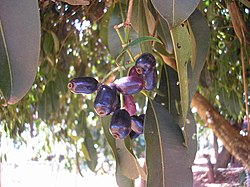Syzygium cumini
| Habit | tree
| |
|---|---|---|
| Height: | ⇕ | 70 ft"ft" can not be assigned to a declared number type with value 70. |
| Width: | ⇔ | 30 ft"ft" can not be assigned to a declared number type with value 30. |
| Lifespan: | ⌛ | perennial |
| Exposure: | ☼ | sun |
|---|---|---|
| USDA Zones: | 11 to 12 | |
| Flower features: | ❀ | white |
|
Syzygium > |
cumini > |
Jambul (Syzygium cumini) is an evergreen tropical tree in the flowering plant family Myrtaceae, native to Bangladesh, India, Nepal, Pakistan and Indonesia. It is also known as Jaam/Kalojaam, Jamun, Nerale Hannu, Njaval,Neredupandu, Jamblang, Jambolan, Jambula, Black Plum, Damson Plum, Duhat Plum, Jambolan Plum, Java Plum or Portuguese Plum. "Malabar plum" may also refer to other species of Syzygium.
A fairly fast growing species, it can reach heights of up to 30 m and can live more than 100 years. Its dense foliage provides shade and is grown just for its ornamental value. The wood is strong and is water resistant. Because of this it is used in railway sleepers and to install motors in wells. It is sometimes used to make cheap furniture and village dwellings though it is relatively hard to work on.
Jambul trees start flowering from March to April. The flowers of jambul are fragrant and small, about 5 mm in diameter. The fruits develop by May or June and resemble large berries. The fruit is oblong, ovoid, starts green and turns pink to shining crimson black as it matures. A variant of the tree produces white coloured fruit. The fruit has a combination of sweet, mildly sour and astringent flavour and tends to colour the tongue purple.
Read about Syzygium cumini in the Standard Cyclopedia of Horticulture
|
|---|
|
Eugenia jambolana, Lam. (Syzygium jambolana, DC.). Jambolan, or Jambolan Plum. Tall shrub or tree: Lvs. broadly oblong, very broad at summit but often shortly apiculate, 2½-5 in. long, 1¾-4 in. wide, thick and shining: berry edible, varying from the size of a cherry to that of a pigeon's egg. E. Indies.—Grown at Santa Barbara, Calif., where, according to Franceschi, the trees become large and flower profusely but never ripen fr. CH
|
Cultivation
Propagation
Pests and diseases
Varieties
Gallery
References
External links
- w:Syzygium cumini. Some of the material on this page may be from Wikipedia, under the Creative Commons license.
- Syzygium cumini QR Code (Size 50, 100, 200, 500)




